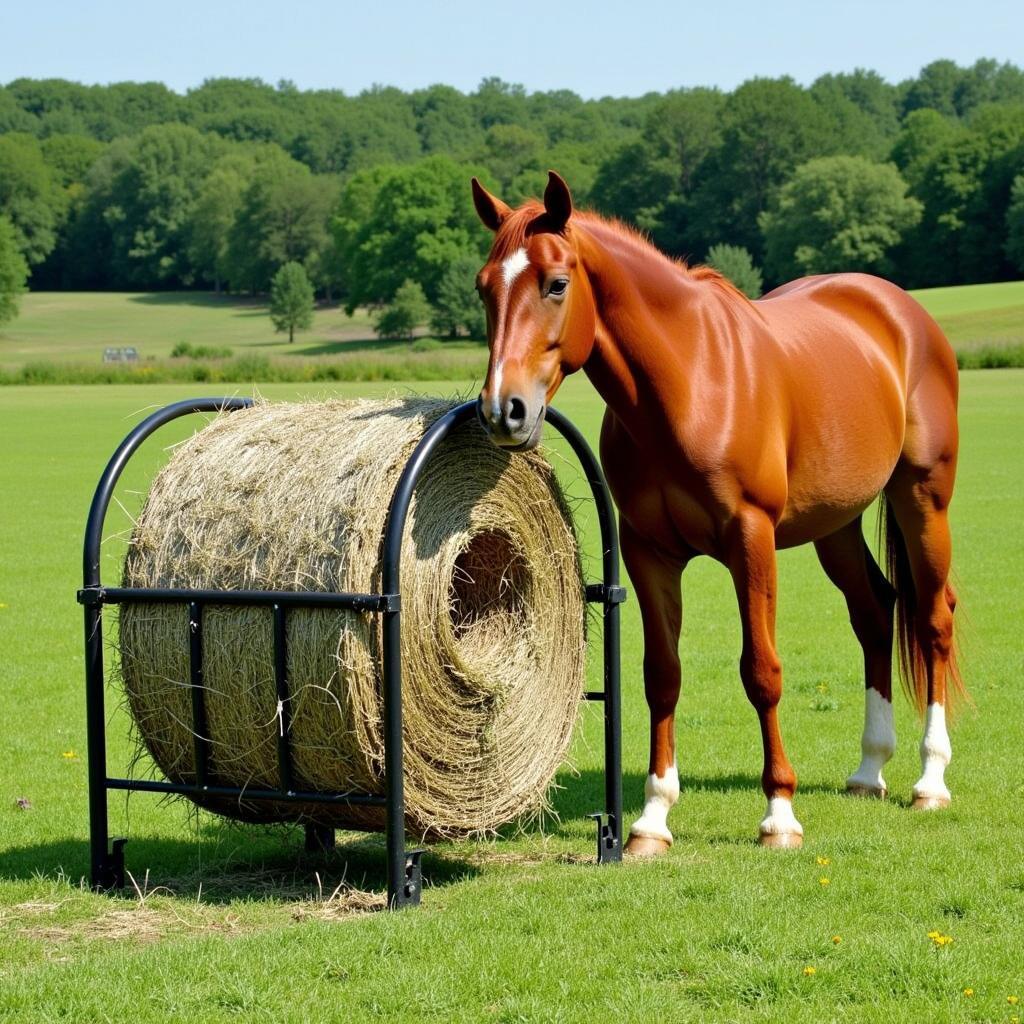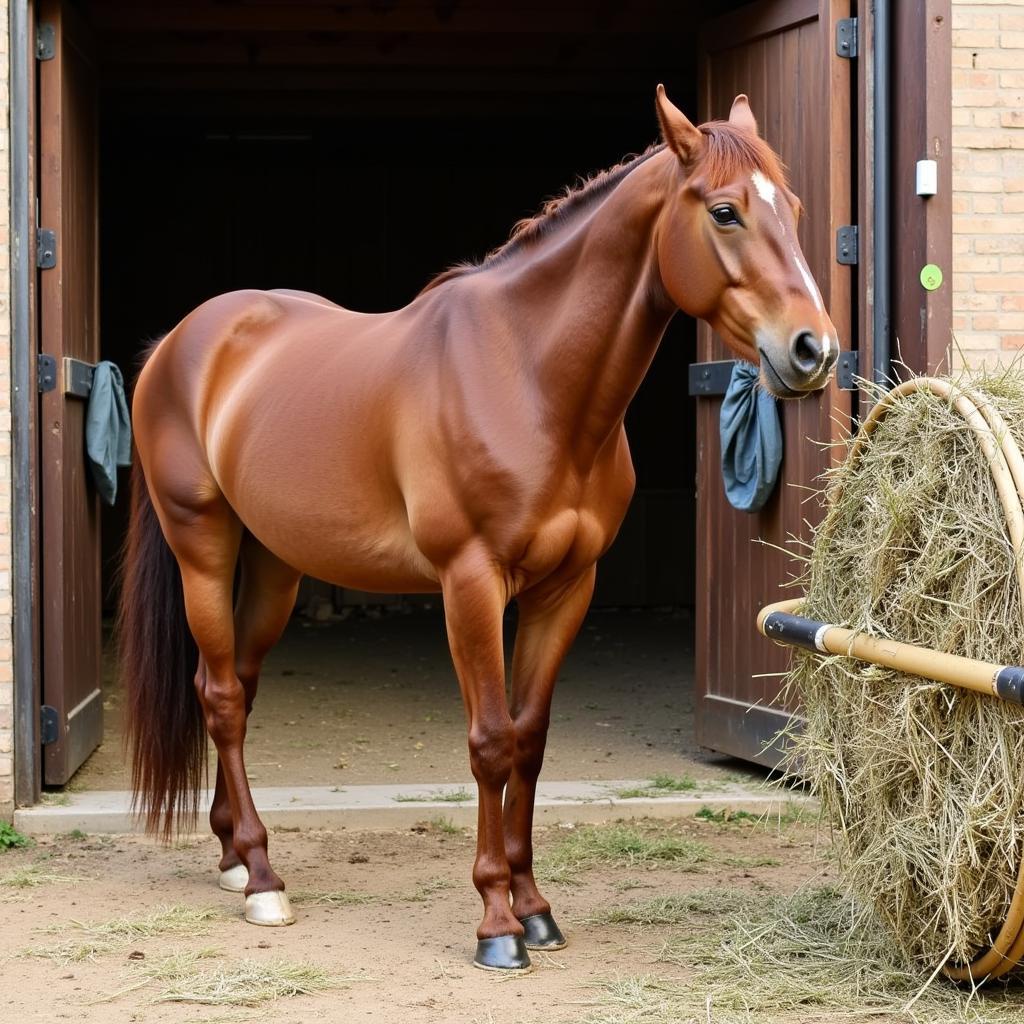Hay bale rings are a common sight in pastures and stables, but are they really necessary? If you’re a horse owner, you’ve probably wondered about their benefits and whether they’re the right choice for your equine companion. This comprehensive guide delves into the world of hay bale rings, exploring their advantages, drawbacks, and how to choose the best one for your horse’s needs.
 Horse eating from a hay bale ring in a pasture
Horse eating from a hay bale ring in a pasture
Why Use a Hay Bale Ring for Your Horse?
Hay bale rings offer numerous advantages for both horses and their owners. Here are some compelling reasons why you should consider investing in one:
Reduce Hay Waste and Save Money
One of the most significant benefits of using a hay bale ring is the reduction in hay waste. When horses eat from a bale placed directly on the ground, they tend to trample and soil a significant portion of it. Hay rings elevate the bale, preventing this unnecessary wastage and ultimately saving you money on hay expenses.
Minimize Respiratory Issues
Horses are susceptible to respiratory problems, especially when exposed to dust and mold commonly found in hay. Hay rings help minimize these risks by keeping the hay off the ground and reducing the amount of dust inhaled by your horse.
Promote Natural Grazing Behavior
Horses are designed to graze for extended periods. Hay rings encourage this natural grazing behavior by slowing down their consumption. This is particularly beneficial for horses prone to overeating or those requiring a controlled diet.
 Horse using a hay bale ring in a stable
Horse using a hay bale ring in a stable
Choosing the Right Hay Bale Ring
The market offers a variety of hay bale ring options, each with its pros and cons. Consider these factors when making your selection:
1. Material: Hay bale rings are commonly made from metal, rubber, or plastic.
- Metal rings are durable and long-lasting but can pose a risk of injury if a horse gets a leg caught.
- Rubber rings are safer and quieter but might not be as durable as metal ones.
- Plastic rings are lightweight and affordable but may crack in extreme temperatures.
2. Size: The size of the ring should correspond to the size of the hay bales you use and the number of horses sharing it.
3. Design: Hay bale rings come in various designs, including open rings, rings with grids, and slow feeders.
- Open rings allow for easy access to hay.
- Rings with grids help further reduce waste by limiting the amount of hay pulled out at once.
- Slow feeders are designed for horses that need to eat more slowly.
4. Portability: Consider whether you need a portable ring that can be easily moved around the pasture or a stationary one for the stable.
Expert Insight
“Choosing the right hay bale ring is crucial for your horse’s well-being,” says Dr. Emily Carter, a renowned equine veterinarian. “Always prioritize safety and select a ring that promotes natural grazing behavior while minimizing hay waste.”
FAQs about Hay Bale Rings
1. Can I leave a hay bale ring in the pasture all the time?
Yes, you can leave a hay bale ring in the pasture year-round, provided it is made from durable material and properly secured.
2. How often should I clean my hay bale ring?
It’s good practice to clean your hay bale ring regularly, ideally every time you replace the hay bale. Remove any debris and disinfect the ring to prevent the spread of bacteria.
 Cleaning a hay bale ring with a brush and disinfectant
Cleaning a hay bale ring with a brush and disinfectant
3. Can I use a hay bale ring for other animals?
Yes, hay bale rings are suitable for other livestock, including goats, sheep, and alpacas. Choose a ring size and design appropriate for the animal.
Need More Help?
Choosing the right hay bale ring is an important decision for your horse’s health and happiness. For personalized advice and assistance in selecting the perfect hay bale ring, contact our expert team at Justus Horses USA. Call us at 0772127271, email us at [email protected], or visit our location at QGM2+WX2, Vị Trung, Vị Thuỷ, Hậu Giang, Việt Nam. We’re available 24/7 to help you provide the best care for your beloved equine companion.